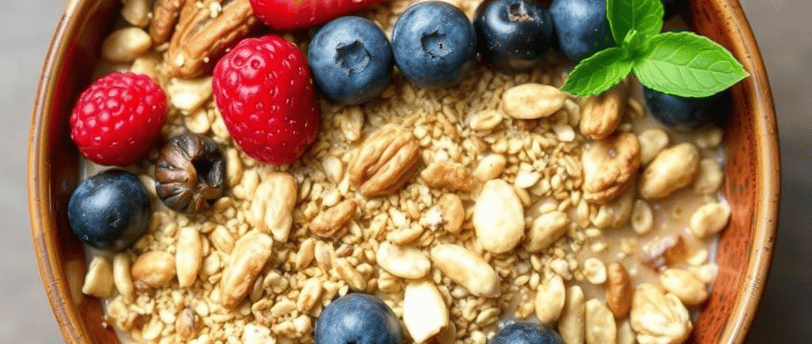Prioritize Fiber-Rich Foods: Enhancing Digestion and Sustaining Fullness
🧘WELLNESS TIPS⚖️ WEIGHT MANAGEMENT & HEALTHY METABOLISM


In an age where quick meals and fast food dominate our dietary habits, the importance of nutrient-rich foods, particularly those high in fiber, often gets overlooked. Fiber is a crucial component of a balanced diet, playing a pivotal role in maintaining digestive health and providing a longer-lasting sense of fullness. In this article, we will delve deeply into the significance of fiber, its various types, health benefits, and practical ways to incorporate fiber-rich foods into our daily meals.
Understanding Fiber
Fiber is a type of carbohydrate that the body cannot digest. While most carbohydrates break down into sugar molecules, fiber cannot be broken down into sugar molecules, which is what gives it its unique properties. There are two main types of dietary fiber: soluble and insoluble.
Soluble Fiber
Soluble fiber dissolves in water and forms a gel-like substance in the digestive tract. This type of fiber is known for its ability to help lower blood cholesterol and glucose levels. Foods high in soluble fiber include:
Oats
Beans
Lentils
Apples
Citrus fruits
Barley
Insoluble Fiber
Insoluble fiber, on the other hand, does not dissolve in water. It adds bulk to stool and aids in the movement of food through the digestive tract, promoting regularity and preventing constipation. Sources of insoluble fiber include:
Whole grains (such as whole wheat and brown rice)
Nuts and seeds
Potatoes (with skin)
Cauliflower
Green beans
Both types of fiber are essential for optimal health, and a balanced diet should incorporate a variety of fiber-rich foods.
The Role of Fiber in Digestion
One of the primary benefits of fiber is its positive impact on digestive health. A diet high in fiber can prevent a range of digestive problems and contribute to overall well-being. Here’s how:
Promotes Regular Bowel Movements
Insoluble fiber adds bulk to the stool, making it easier to pass. This promotes regular bowel movements and can help prevent constipation. By keeping the digestive system running smoothly, fiber mitigates the risk of conditions like diverticulitis and hemorrhoids.
Reduces the Risk of Colon Cancer
Numerous studies have suggested that a high-fiber diet is associated with a reduced risk of colorectal cancer. Fiber may help by aiding in bowel regularity and binding potential carcinogens in the intestine, possibly leading to their excretion.
Supports a Healthy Gut Microbiome
Dietary fiber serves as food for the beneficial bacteria in our intestines. These bacteria ferment fiber, producing short-chain fatty acids (SCFAs) that nourish colon cells and contribute to gut health. A healthy gut microbiome is linked to numerous health benefits, including enhanced immune function and reduced inflammation.
The Satiety Factor: Staying Full Longer
In addition to digestive benefits, fiber plays an essential role in satiety—helping individuals feel full longer after eating. This can lead to reduced calorie intake, aiding weight management and preventing overeating. Here’s how fiber contributes to a feeling of fullness:
Slows Down Digestion
Foods high in soluble fiber slow the rate of digestion and absorption in the stomach, keeping you full for longer. This slowdown allows for a gradual release of glucose into the bloodstream, preventing spikes in blood sugar levels and subsequent crashes that often lead to hunger pangs.
Reduces Energy Density
Fiber-rich foods tend to be lower in energy density, meaning they have fewer calories for a given volume of food. Incorporating fiber into meals can help individuals consume larger portions without significantly increasing caloric intake, thereby promoting weight management.
Supports Hormonal Regulation
Fiber intake influences the release of hormones that regulate appetite, including ghrelin (the hunger hormone) and peptide YY (a hormone that promotes feelings of fullness). A higher intake of fiber can lead to lower levels of ghrelin and higher levels of peptide YY, helping to control hunger.
Practical Tips for Incorporating Fiber-Rich Foods
To reap the benefits of fiber, it’s essential to prioritize fiber-rich foods in your diet. Here are some practical tips for increasing dietary fiber:
Start Your Day with Fiber
Consider opting for a bowl of oatmeal topped with fruits and nuts or a smoothie made with leafy greens, a banana, and a tablespoon of chia seeds. These fiber-rich breakfasts will set a positive tone for the day.
Snack Wisely
Instead of reaching for processed snacks, try munching on raw vegetables, hummus, or a piece of fruit with peanut butter. These options not only provide fiber but also deliver essential nutrients.
Choose Whole Grains
Opt for whole-grain bread, pasta, and rice instead of refined grains. Whole grains are rich in fiber and other micronutrients, making them a healthier choice overall.
Add Legumes
Incorporating beans, lentils, and chickpeas into salads, soups, or stir-fries adds significant fiber content to your meals. They are also excellent sources of plant-based protein.
Gradually Increase Fiber Intake
When increasing fiber in your diet, do so gradually to allow your digestive system to adjust. Additionally, remember to drink plenty of water to help fiber do its job effectively, reducing the potential for digestive discomfort.
Conclusion
Prioritizing fiber-rich foods is a simple yet powerful strategy for improving digestion and enhancing feelings of fullness. As we become more aware of the importance of a well-rounded diet, focusing on fiber can yield considerable health benefits. With a little planning and creativity, incorporating fiber into daily meals can transform one’s approach to eating and lead to a healthier, more satisfying lifestyle. So, make it a priority—your gut will thank you!
